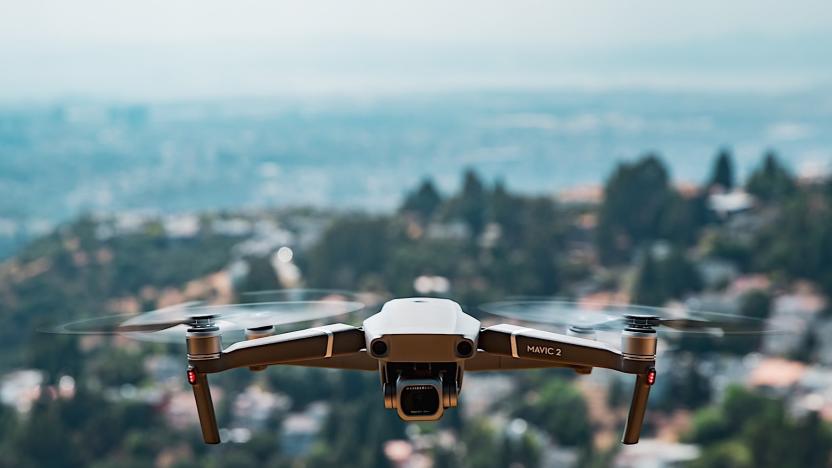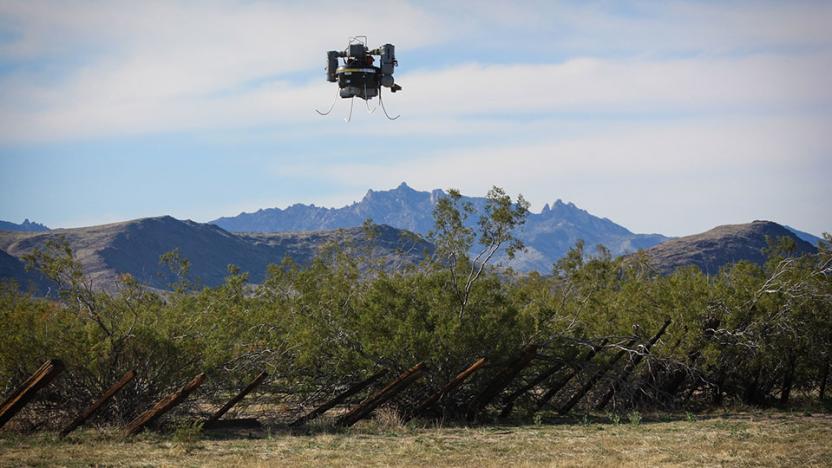ATC
Latest

DJI drones will detect and warn of airplanes and helicopters
DJI has announced that all its consumer drones over 250 grams will use "AirSense" tech to help operators see and avoid airplanes and helicopters. They'll be equipped with so-called ADS-B sensors already installed in many aircraft and air traffic control (ATC) towers. Drone pilots will be able to see air traffic on their controllers and take evasive action if the system will warns of any potential collisions. "ADS-B was designed for airplanes and helicopters, but already there are more drones in the sky than any of them," said DJI VP of policy Brendan Schulman.

Most US rail operators won't meet deadline for train safety controls
According to a US Government Accountability Office (GAO) report, as many as 70 percent of rail operators won't meet the end of the year deadline for safety controls. Operators are legally required to install positive train control (PTC) systems that slow trains traveling too fast (based on location) by the end of the year. The GAO says that only five rail companies will meet the December 31st deadline to have the safety tech in place. An automatic train control (ATC) system was only installed in one direction on the section of track where an Amtrak train derailed near Philadelphia earlier this year. As you might expect, the safety feature may have prevented that accident entirely by automatically adjusting the train's speed for that portion of the route. [Image credit: Andrew Harrer/Bloomberg via Getty Images]

FAA says a buggy software update grounded flights
Ever got a bad smartphone update? Now imagine that your phone controls air traffic on the Eastern seaboard, and you have some idea what happened to flights on Saturday. The FAA said that a software update that was supposed to help controllers see frequently used info at a radar facility ended up bringing down the overall system. That caused the cancellation of hundreds of flights in Baltimore and Washington, DC, reducing capacity up to 28 percent. The agency said everything's fine now that it's disabled the new function, and it's working with Lockheed Martin to figure out why the bug wasn't caught in testing. Meanwhile, you can now factor software glitches, hacking and bad routers into your flight plans.

NASA explains how cell networks can restrict drone flights
NASA has taken on the job of preventing drones from crashing into things, and it's now revealed more info about how it plans to do that. It wants to link up drones up to a control system when they're flying, then "geo-fence" them off from trouble, according to its latest missive. And as the space agency mentioned earlier, one way it could communicate with them is via cellphone networks like Verizon's. A central system would use them to transmit information to drones, helping them steer away from restricted areas and other aircraft. Creating such a network, which NASA calls the UAS traffic management system (UTM) would be a challenge, however.

Amtrak installs automatic train controls before service resumes
Following the deadly accident last week near Philadelphia, Amtrak installed a braking system on the section of track that could've prevented the derailment. The automatic train control system (ATC) keeps tabs on a train's speed as it heads toward curves, automatically adjusting it if the conductor fails to do so. ATC was already used for southbound trains in this spot, but not for those headed northbound like the one that derailed last Tuesday. In addition to the ATC, Amtrak is working to equip trains with a Positive Train Control system (PTC) which uses the ATC to further automate trains while avoiding collisions, maintaining safe speeds and providing safer conditions for work crews. Amtrak plans to have the PTC in place by the end of the year. The Federal Rail Administration announced today that Amtrak had completed all of its requirements to resume service along the Northeast Corridor between Washington, DC and Boston, and that the train company would continue to evaluate other curves along the route. [Image credit: Mark Makela/Getty Images]

NASA explains why you won't get a drone delivery anytime soon
Delivery drones are great at exactly one job right now: generating buzz. However, NASA has told the New York Times that actual widget-shipping drones from Amazon or Google are still far in the future. And the space agency should know: it has taken on the task of developing an "air traffic control" (ATC) system for drones flying below 400 feet. Such a system would be run by computers without human aid, and take into account weather, air traffic, geographic obstacles and other factors. The space agency is quite familiar with existing air traffic issues, as it has been advising the FAA on the NextGen system for "real" planes. Armed with that know-how, it sees a number of problems for UAV couriers.

Chaos Theory: The wonderful world of sabotage in TSW
It's certainly no secret that I love The Secret World's investigation missions. I have mentioned it a time to two (times 20 or so) at different points in articles and livestreams alike. And that's not even counting how many times I regale my friends and family with my investigative exploits. Getting to use skills of the mind more than the fingers is not a regular occurrence in MMORPGs, but it darn well should be! It is a refreshing alternative to pew-pew all the time. However, investigations aren't the only unique breed of missions I love in TSW. The game has a second kind that involves something other than just going out and showing off your prowess with a weapon. In fact, significant portions of these missions actually eschew the use of weapons entirely, and engaging in combat is a pretty big no-no when completing certain objectives. Welcome to sabotage missions.

UK investigating passive radar system to detect aircraft location, free up 5G spectrum
Ready for a new radar system? The UK could be, if a new study is deemed a success. Thales, a French aerospace company which manufactures traditional radar systems, has received funding from the UK's Technology Strategy Board to study the feasibility of using TV signals to locate planes and choppers through a technology called "passive radar." According to the BBC, the system would monitor the timing of TV signals reflected from aircraft, which would enable equipment to display an exact location, while measuring the Doppler effect would provide speed and direction information. Though it's not based on GPS, the new system would reportedly be more accurate and efficient than what's in use today, while also serving to free up spectrum that could be used for an upcoming 5G network. Unconvinced frequent fliers need not worry, however -- the country's existing radar infrastructure would remain intact throughout the test period, and air traffic control officials won't be switching to the new system unless it's sanctioned, which, considering the significance of such a move, could take some time.

Congress passes bill giving the FAA $11 billion to get off radar, onto GPS
It took awhile, and the price tag is quite a bit steeper than previously thought (shocking, right?), but the FAA is finally getting the funding it needs to bring the nation's air traffic control system up to date. Congress just passed the bill to make it happen, allotting $11 billion to the FAA to upgrade the nation's 35 busiest airports air traffic controls from radar to GPS. The deadline for the conversion is June 2015, and when complete, it'll allow for more precise positioning of aircraft -- GPS pings for the planes' locations every second, while radar updates their locations every 6 to 12 seconds. With such technology enabled, airplanes will be able to take-off and land more closely together while utilizing steeper descents than is currently possible to conserve fuel. So, now that we've got the new traffic control system to improve airline punctuality, we just need the FAA and the FCC to team up and eliminate the "Terrible 10,000 feet" and flying might actually be fun.

Oregon Scientific unveils ATC Beats WiFi sports cam and ATC Chaméléon dual-lens camera
Joining Oregon Scientific's range of waterproof sports cameras later this year are these two new models: the ATC Beats on the left and the ATC Chaméléon on the right. The Beats, arriving in November for $399, features 1080p 60fps video capture with a 130-degree field of view and a 270-degree rotatable lens, along with built-in GPS, accelerometer and heart rate monitor (via wireless chest belt) for those keen on recording some extra data. Most importantly, though, is its WiFi connectivity with any iPhone or Android device: not only can you do wireless file transfer with it, but much like the way ContourGPS Connect View app works, you can also use your phone as a wireless viewfinder. Pretty handy for when the camera's stuck on a helmet, of course.The Chaméléon, on the other hand, is slated for a September launch at $199 only. While it doesn't have all those fancy wireless features, it boasts two 180-degree rotatable lenses (with a 110-degree field of view) at each end of the long body: one moves horizontally, and the other moves vertically; hence the name. The idea is that the camera can simultaneously capture 720p 30fps footage from both lenses (there's only one camera controller inside), and then output a synchronized horizontal or vertical split-screen video clip. We can already picture the Chaméléon being used on a surfing board or in a racing car, so there's certainly great potential here. Anyhow, enjoy our hands-on photos while you imagine the adrenaline rush.

GPS-based air traffic control system to go live by 2020
If you've ever watched an investigative journalism show that exposes things you didn't know you had to worry about, there's a good chance you've seen footage of the archaic green-screens in use at airport towers across the country paired with shocking headlines like "Hidden Airport Menace" or "Glidepath to Danger." Plans to replace that tech are finally in motion, with the FAA indicating its new air traffic control system will go into effect by 2020, possibly as early as 2015. This system requires that any aircraft flying within commercial airspace must have a GPS-equipped navigation system -- and we don't mean a TomTom stuck on the windshield. These systems will cost between $5,000 and $10,000 for small planes and are able to beam information to ground control stations that will no longer have to rely exclusively on radar. The plan could cost the FAA alone roughly $4 billion, giving bored local news personalities something else to sensationalize.

ATC's P1 amplifier gives its passive speakers some teeth
We tend to associate the ATC (Acoustic Transducer Company) brand with active speaker systems, but the British firm has a number of passive speakers in its lineup as well. You just know with its powered speaker heritage, the company has some definite opinions about what kind of amp to partner up with those passive loudspeakers, and it's a safe bet that ATC's own P1 amp would come highly recommended, indeed. The dual mono, Class A/B juicebox boasts 150-Watts (into 8-Ohms) and specs out at better than 110dB signal to noise ratio with distortion way down at -95dB. Definitely a piece for the well-heeled, the $3,700 P1 also packs the XLR inputs that will keep your British audiophile cred intact.

Contest winner's playlist will be sent to space aboard iPod
As if there weren't enough reasons to want to be a kid again, the European Space Agency is holding a contest for children 18-and-under that requires crafting the perfect playlist for astronauts floating around the International Space Station -- and the lucky winner scores a trip to South America to watch an iPod loaded with his/her tunes launched aboard the agency's Automated Transfer Vehicle. In a twist on the old "What would you bring to a desert island" question, the contest -- which is only open to residents of EU countries participating in the ATV program -- asks entrants to envision what ten songs they'd want to listen to (guess they're only sending up a shuffle) as they orbited 400 kilometers above the Earth, and although the rules don't specifically prohibit it, we imagine that entries which include "Major Tom," "Free Fallin'," or "Also Sprach Zarathustra" (not to mention anything by the Beatles) will be immediately disqualified. Now when the 20-tonne vehicle heads off towards the ISS later this year, it certainly won't be carrying the first iPod into orbit -- Anousheh Ansari famously brought hers up last year, among others -- and with the "Gates in Space" story now definitively debunked (tourist Charles Simonyi attributed the rumor to a Russian press "notorious for their fabrications") it looks as though space -- much like many places on Earth -- will remain a decidedly Zune-free zone for the foreseeable future. [Via FARK, image courtesy of NASA]

Radiient offers up 4-port HDMI switch / hub
While we've taught you how to craft your own component video switch (not to mention your own cables), there will (probably) come a time in your 1080p-needing life where that sole HDMI port on the rear of your television just won't cut it. Enter Radiient's HDMI Switch Select-4, a 4-port HDMI hub that doesn't deviate too far from the other alternatives already out there, but cuts out the audio ports altogether while adding in an RS-232 control port. Also, this device features a bevy of colorful LEDs, sure to enthrall some users who want to control things with the lights out while enraging others who like things pitch black when catching a flick. Nevertheless, the Select-4 supports HDCP, DVI (via adapters), and all your standard HD resolutions right up to 1080p. Notably, this sucker doesn't seem to support the recently-unveiled 1.3 spec, which means you'll miss out on some of the extra niceties on that shiny PlayStation 3. Still, Radiiant apparently feels its HDMI switcher is worth its weight in gold, as this bad boy will run you a whopping ¥69,300 ($592). Update: These things have a $299 US asking price (at least as of right now). Thanks Jacobim.[Via Akihabara News]

MSI announces world's first "HDMI certified" graphics card
To be honest, we weren't really aware of the existence of such certification, or that it was lacking in most graphics cards, but MSI is parading around their new shiny gold star they just received from the HDMI Authorized Testing Center (ATC) in regards to their new NVIDIA-based NX7600GT Diamond Plus. They're claiming to have received the first such certification for an HDMI graphics card, which means their card matches certain standards for compatibility and stability that will allow it to play nice with all the other HDMI kids. Apparently HDCP is in full effect here as well, so there shouldn't be any problems with that end of standard support. MSI's card also offers some D.O.T. II overclocking performance along with all that compatibility, but we're not sure on price or availability of the new card.








